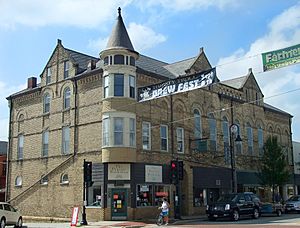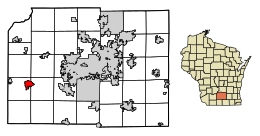Mount Horeb, Wisconsin facts for kids
Quick facts for kids
Mount Horeb, Wisconsin
|
|
|---|---|
|
Village
|
|

Mt. Horeb Opera Block on Main Street.
|
|

Location of Mount Horeb in Dane County, Wisconsin.
|
|
| Country | |
| State | |
| County | Dane |
| Area | |
| • Total | 3.23 sq mi (8.35 km2) |
| • Land | 3.23 sq mi (8.35 km2) |
| • Water | 0.00 sq mi (0.00 km2) |
| Elevation | 1,243 ft (379 m) |
| Population
(2020)
|
|
| • Total | 7,754 |
| • Estimate
(2019)
|
7,534 |
| • Density | 2,336.12/sq mi (901.86/km2) |
| Time zone | UTC-6 (Central (CST)) |
| • Summer (DST) | UTC-5 (CDT) |
| Area code(s) | 608 |
| FIPS code | 55-54725 |
| GNIS feature ID | 1569817 |
Mount Horeb is a village in Dane County, Wisconsin, United States. In 2020, about 7,754 people lived there. It is part of the larger Madison metropolitan area.
Contents
History of Mount Horeb
The Ho-Chunk Nation's Land
The area where Mount Horeb is located was once the home of the Ho-Chunk nation. Their name means "People of the Sacred Language." Starting in 1829, the Ho-Chunk faced pressure from European and American settlers. Their land was opened up for farming and lead mining.
The Ho-Chunk nation gave up their land to the United States government through several agreements. The 1829 agreement included the future site of Mount Horeb. Because of these agreements and other pressures, the tribe was forced to move west across the Mississippi River. Today, the Ho-Chunk tribe does not have one large reservation. Instead, they own about 8,800 acres spread across twenty counties in western Wisconsin.
How Mount Horeb Started
Settlement in Dane County began in 1828. This was when Ebenezer Brigham found lead in the Blue Mounds area. He then opened a tavern and an inn.
In 1849, James Morrison bought the land that would become Mount Horeb. A year later, he sold some of it to Granville Neal. Early settlers came from England, Ireland, Germany, Scotland, and other parts of the United States.
As more people moved to the Blue Mounds area, a new post office was needed. In 1861, the first post office in Mount Horeb opened in the home of George Wright. He was an English immigrant and a Methodist minister. Wright chose the name Mount Horeb for the settlement. The "Mount" part came from the hills around the area. "Horeb" comes from a place in the Bible where Moses received the Ten Commandments.
Later, the post office moved closer to the settlement, which was called "The Corners." The name changed to "Horeb's Corner" before officially becoming Mount Horeb.
Norwegian Immigrants Arrive
Norwegian immigrants have greatly shaped the history and culture of Mount Horeb and Wisconsin. The first Norwegian immigrant came to Wisconsin in 1838. By 1870, over 59,000 Norwegians lived in Wisconsin. Many of them settled in Dane County.
In 1871, Andrew Levordson was the first Norwegian immigrant to arrive in Mount Horeb. This marked the beginning of a strong Norwegian presence in the village.
Little Norway Museum
Mount Horeb had many Norwegian and Norwegian-American residents. They wanted to show off their heritage through museums and tourist spots. One such place was Little Norway, Wisconsin, near Blue Mounds.
In 1856, Osten Olson Haugen and his family, who came from Norway, started a farm there. In 1926, Isak J Dahle, who grew up in Mount Horeb, bought the farm. He renamed it Nissedahle. This name was a play on words. "Nisse" (pronounced NISS-uh) are playful elves in Norwegian stories. They help people if they are treated well. "Nissedal" means "Valley of the Elves." Dahle added his last name to make "Nissedahle."
Dahle turned the farm into a living history museum. It showed an ideal version of old Norway. It opened to the public in 1934. A special part of Little Norway was a replica of a 12th-century "Stavkirke" (stave church). This wooden church was built in Norway for the 1893 World's Columbian Exposition in Chicago, Illinois. It was later given to Dahle in 1935. The church held over 7,000 old items.
Little Norway became a popular attraction. Visitors could learn about Norwegian immigrant life. After 85 years, Little Norway closed due to money problems. Many items were sold, and the stave church went back to Norway. Today, you can take virtual tours of the stave church at the Driftless Historium in Mount Horeb.
Song of Norway Play
After a trip to Scandinavia, Mount Horeb artist Oljanna Cunneen suggested a festival. She thought a play about Norwegian culture would be fun. In 1966, Mount Horeb put on "Song of Norway" for the first time. This play is an operetta about the famous Norwegian composer, Edvard Grieg.
The first show was at the Tyrol Ski Basin. In 1979, the play moved to the Cave of the Mounds, where a permanent outdoor stage was built. Local and professional actors performed in the play. People from the community made the Norwegian folk costumes, like the bunad. The play ran every summer until the early 2000s.
The Troll Capital of the World
In the 1980s, Mount Horeb wanted to keep celebrating its Norwegian heritage. Also, a new highway bypass was built, taking traffic away from the town center. To solve this, Mount Horeb decided to become the "Troll Capital of the World."
In Norwegian folklore, trolls are often small, ugly, and have tails. The trolls in Mount Horeb are based on these stories. Residents have placed these fun characters all over the village. Most of them are along Main Street, which is now called "The Trollway." You can find trolls painted, sculpted, or carved from logs. Each of the 40 trolls in Mount Horeb has its own unique look and name, like "The Chicken Thief" or "The Accordion Player."
The "Trollway" idea came from the Chamber of Commerce. They wanted to bring visitors back to Main Street to support local businesses.
Geography of Mount Horeb
Mount Horeb is in southwestern Wisconsin. It is part of a special area called the Driftless Area. This area includes parts of Minnesota, Iowa, and Illinois. The Driftless Area is unique because glaciers went around it. This left behind rolling hills instead of the flat land found in other places.
The Village of Mount Horeb is in southwestern Dane County. The edge of the Driftless Area runs through the middle of the county. Mount Horeb is also close to Blue Mound State Park. You can also access the Military Ridge State Trail from here. Mount Horeb is about 20 miles southwest of Madison, the state capital. Madison is also home to the University of Wisconsin–Madison.
Mount Horeb is located along U.S. Highway 151. The village covers a total area of about 3.25 square miles (8.35 square kilometers).
Population of Mount Horeb
| Historical population | |||
|---|---|---|---|
| Census | Pop. | %± | |
| 1880 | 42 | — | |
| 1900 | 864 | — | |
| 1910 | 1,048 | 21.3% | |
| 1920 | 1,350 | 28.8% | |
| 1930 | 1,425 | 5.6% | |
| 1940 | 1,610 | 13.0% | |
| 1950 | 1,716 | 6.6% | |
| 1960 | 1,991 | 16.0% | |
| 1970 | 2,402 | 20.6% | |
| 1980 | 3,251 | 35.3% | |
| 1990 | 4,182 | 28.6% | |
| 2000 | 5,860 | 40.1% | |
| 2010 | 7,009 | 19.6% | |
| 2020 | 7,754 | 10.6% | |
| U.S. Decennial Census | |||
2010 Census Information
According to the census from 2010, there were 7,011 people living in Mount Horeb. There were 2,696 households and 1,878 families. The population density was about 2,156 people per square mile (832 people per square kilometer).
Most of the people living in the village were White (96.0%). About 0.8% were African American, 0.2% Native American, and 0.6% Asian. About 1.7% of the population was Hispanic or Latino.
The average age in the village was 35.5 years old. About 29.5% of residents were under 18 years old. About 11.4% were 65 years or older.
Businesses and Activities in Mount Horeb
Mount Horeb offers good access points to the Military Ridge State Trail. This is a 39-mile (63 km) bicycle trail built on an old railroad path.
Mount Horeb was once home to the Mount Horeb Mustard Museum. This fun museum had many types of mustard to try and buy. It also showed a large collection of unusual mustards and antique mustard jars. The museum was featured on TV shows and radio programs. In 2009, the Mustard Museum moved to Middleton, Wisconsin. It is now called the National Mustard Museum.
Mount Horeb is sometimes called the "Mustard Capital of the World." It is also known as the "Troll Capital of the World." The main street is called the "Trollway," and troll statues decorate many businesses. This shows Mount Horeb's strong Norwegian heritage.
Mount Horeb is also home to the Gonstead Clinic of Chiropractic. It was started in 1939 by Dr. C.S. Gonstead. He developed a well-known method for spinal adjustment. The clinic became a nationally recognized center for chiropractic care.
In 2016, Duluth Trading Company announced it would move its main office to Mount Horeb.
Notable People from Mount Horeb
- Herman Dahle — a member of the U.S. House of Representatives from Wisconsin.
- Clarence Gonstead — a famous chiropractor.
- Carl M. Grimstad — a member of the Wisconsin State Assembly.
- Edmund Hillestad — a member of the South Dakota House of Representatives.
- William C. Kahl — Wisconsin Superintendent of Public Instruction.
- Roberta E. Sebenthall — a novelist and poet.
See also
 In Spanish: Mount Horeb (Wisconsin) para niños
In Spanish: Mount Horeb (Wisconsin) para niños

